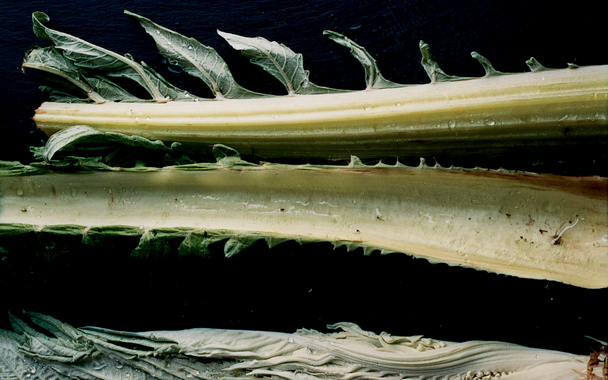About every other Saturday morning I run into Kemp Minifie, Gourmet’s executive food editor, at the Greenmarket where we do our weekly shopping. This last weekend she peered into my bag and noticed two big bunches of cardoons. “What are you going to do with those?” she asked. “We’ve run a bunch of recipes in the magazine and they’re fine, even good, but I’m just not feeling the love.”
“I had a conversion experience,” I told her. “I’ve made cardoons three or four times every year and have never been thrilled. But I went to a dinner that Bill Telepan cooked at Tim Stark’s farm in September, and he served these unbelievable cardoon bread puddings, and I pestered him until he gave me the recipe.”
The short story on cardoons is this: They’re part of the thistle family. They share the genus Cynara with artichokes and look a lot like artichokes in the field, although one eats the stems of cardoons instead of the flowers. Those stems are tough and spiny, and need to be trimmed along the edge with a knife and then peeled on both sides to remove the tough fibers running up and down the outside.
What you end up with is pieces of vegetable with a subdued version of artichoke’s flavor and more bitterness. That subtle flavor confused me until I tried these bread puddings, which play the bitterness and earthiness off lavish richness. It’s my new favorite way to eat cardoons.
Bill Telepan’s Cardoon Bread Pudding
Makes about 8 4-ounce servings
Trim the edges of 2 quarts cardoons, peel the stems of their fibers, and slice them into 1/4-1/2 inch pieces. Put the cardoon slices in 4 quarts of cold water with plenty of salt and a lemon cut in quarters, and bring it all to a boil, then drain the cardoons. This will speed up the cooking and reduce the bitterness.
Melt 2 tablespoons of butter in a wide pan over low-to-moderate heat, add 1/2 sliced onion and 1 clove minced garlic and cook gently for about 5 minutes, until the onions are softened but not brown.
Add the cardoons and 1 cup of vegetable or chicken stock and cook until the cardoons are tender. This might take 20 minutes or it might take an hour. Cool the vegetables on a tray.
Mix together 10 egg yolks and 1 quart of cream, then whisk in 2 tablespoons of grainy mustard and pour this mixture over 4 cups of diced bread. (Bill calls for brioche. I made it with white bread. His version is better, though mine is still worth making.) Let this sit for 20 minutes, then mix with the cardoons, breaking up the bread so that any remaining pieces are small enough to soak through (no bigger than, say, half a walnut).
Pour the mixture into eight 4-ounce ramekins and bake in a hot water bath at 325 degrees for about 20 minutes, until the custard is just set. Take the ramekins out of the water and put them back in the oven for 10-15 minutes until they’re brown and well-set.
I served this to my in-laws this week with a roast chicken and the last of the fresh flageolet beans. There was much rejoicing.




 Pinterest
Pinterest


